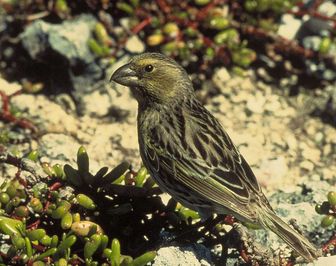Laysan Finch
The Laysan Finch is a large honeycreeper with a heavy bill. Overall the male has yellow plumage with a whitish belly and a grey neck. The female is duller than the male, with brown streaking. It is almost impossible to confuse the Laysan Finch with any other bird in the field as it is the only passerine species found on the few islands it lives on.

The Laysan Finch is classified as Vulnerable (VU), considered to be facing a high risk of extinction in the wild.
Laysan Finches were listed as Endangered by the U.S. Fish and Wildlife Service in March 1967. The island of Laysan is part of the Hawaiian Islands National Wildlife Refuge (NWR), thereby providing protection for the species' habitat. Laysan is not a populated island, and access to it is strictly controlled. More
Laysan Finch song has been described as “canary-like” (Bryan 1917), explaining why the species has sometimes been called the “Laysan Canary” (Munro 1960). In the late 1800s and early 1900s, Laysan Finches were taken to Honolulu, O‘ahu I., and elsewhere to be kept as cage birds, but eventually all died, almost certainly owing to their vulnerability to avian diseases (Wilson 1890, Warner 1968, Ely and Clapp 1973, van Riper et al. 1986). More
The Laysan Finch (Telespiza cantans) is a species of finch in the Hawaiian honeycreeper subfamily, Drepanididae, that is endemic to the Northwestern Hawaiian Islands. It is one of four remaining finch-billed Hawaiian honeycreepers, and is closely related to the smaller Nihoa Finch. The Laysan Finch is named for Laysan, the island to which it was endemic on its discovery. It was subsequently introduced to a few other atolls, and its historical range included some of the main islands. More
The Laysan Finch is common on Laysan Island in the northwestern Hawaiian Island chain. A small introduced populations exists on Pearl and Hermes Reef. It is omnivorous, eating carrion, various invertebrates, seeds, roots, and seabird eggs. They are very curious and have no fear of humans. Photo by S. Conant Click on image for a larger view. More
Laysan Finch: Four to five white eggs with small blotches and spots of brown or lilac-gray are laid in a cup-shaped nest in the crotch of a tree. Incubated by female for 15 to 16 days. Foraging and Feeding Laysan Finch: Very adaptable and omnivorous. Feeds on seeds, invertebrates, roots, carrion, and seabird eggs. Vocalization Laysan Finch: Song is a complicated melody and call is a whistled "pee-o-wheet". More
* The song of the Laysan Finch has been described as "canary-like", for this reason it is sometimes called the Laysan Canary. * Rabbits were introduced to Laysan Island in 1903, they devoured the vegetation causing the numbers of this bird to drop to around 100; other endemic species became extinct. These birds survived the lean times by eating eggs and dead birds. More
The Laysan Finch is naturally restricted to the remote island of Laysan in the Hawaiian Islands National Wildlife Refuge, with a small introduced population on Pearl and Hermes Atoll; an introduced population at Midway Atoll was extirpated by rats around 1944. At present the population fluctuates around a mean of some 11,000 individuals. More
the Laysan Duck and the Laysan Finch, survive to this day, but are endangered. Recent history Like most of the Northwestern Hawaiian islands, Laysan is currently uninhabited. It is protected by the Hawaiian Natural Life Act of 1961 and cared for by the U.S. Fish and Wildlife Service, who have had success in eliminating pests, restoring the island to almost pre-desert state, and restoring the numbers of imperiled species. More
The Laysan Finch is a large honeycreeper with a heavy bill. Overall the male has yellow plumage with a whitish belly and a grey neck. The female is duller than the male, with brown streaking. It is almost impossible to confuse the Laysan Finch with any other bird in the field as it is the only passerine species found on the few islands it lives on. More
In the 20th century the Laysan finch suffered from predation and competition by introduced rats and rabbits, though once these alien species were exterminated, the finch populations recovered rapidly (2). Other pressures on the island are taking their toll on this rare bird. Storms and droughts are extremely damaging and can destroy nests and sweep young and adult birds out to sea (3). More
The Laysan Finch nests in vegetation, laying 3 eggs in a cup shaped nest. These are incubated for 16 days by the female, the male in turn feeding the female. The chicks fledge after three weeks, and are cared for by the parents for another three weeks. The Laysan Finch is a generalist, feeding on seeds, small insects, fruits, carrion (of seabirds and Hawaiian Monk Seals), and the eggs of nesting seabirds. More
The Laysan finch is a member of the honeycreeper family. The adult male has a yellow head, breast, and back, a gray neck collar, and whitish belly. The adult female has a yellow crown with some brown streaking, a gray collar, yellow throat and breast, and the back feathers have dark brown spots edged with brown with a trace of yellow. Yellow on the female is less brilliant than that on the male. The length is 6 to 6. More
Laysan Finch - Definition = Laysan Finch Conservation status: Vulnerable Image:Laysanfinch41. More

Family : Fringillidae
Genus : Telespiza
Species : cantans
Authority : Wilson, 1890
